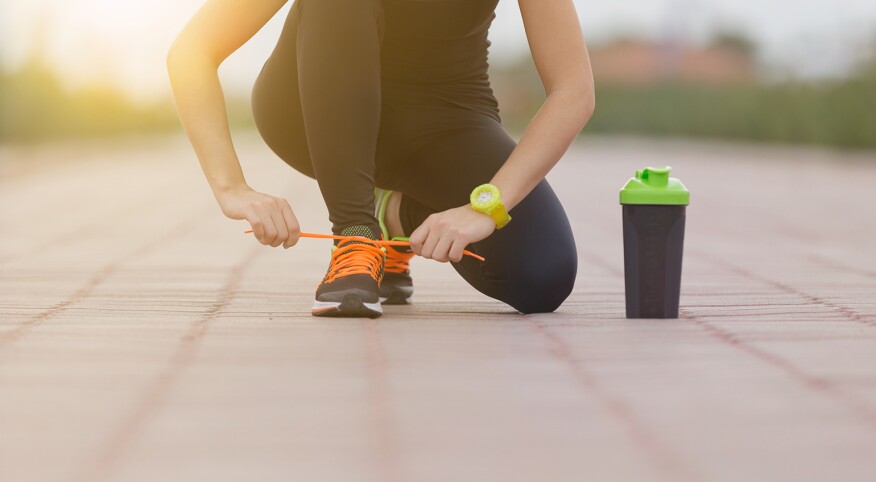Ladies, we’ve got a few bones to pick, and sadly, these bones probably aren’t as strong as they used to be. It might seem ridiculous to most of us to be thinking about bone density when we’re strong and on the go all the time. Nobody here is worried about breaking a hip or sporting a widow’s hump under her sports bra. But the truth is that our bones are constantly rejuvenating, and just like our metabolism, that rejuvenation slows down over time. Old bone is constantly being stripped away so that new bone can form.
“It’s like sandblasting and painting a bridge,” says Brian Peck, M.D., an osteoporosis expert from the Arthritis Center of Connecticut. (He also happens to be my father… I’ve been taking vitamin D and calcium since I was 12.) “The sandblasting crew blasts all the rust and paint off, and then the painting crew comes through and lays down a nice, new coat of paint to seal the bridge,” Dr. Peck explains. “The key is making sure that the sandblasting doesn’t move at a faster rate than the repainting.”
It’s never too late to take a few simple steps toward strengthening your spine … and your femur, and your clavicle … so here are some easy ways to get dense today.
1. MILK IT
Most of us grow up drinking milk, and then as adults we tend to stop (often replacing it with chardonnay). But even as adults, we still need to be getting our calcium, the most important nutrient for bone health along with vitamin D. Even though we tend to slow down on the dairy as adults, the truth is that the dairy requirements for all ages are quite similar. You need three to four dairy servings per day. What’s a serving? An eight-ounce glass of milk, a cup of yogurt or (wait for it) a bowl of ice cream! Don’t like dairy, or have lactose intolerance? Relax. It’s perfectly fine to fulfill your calcium needs via supplements. Just check with your doctor to find out what brand and amount of calcium supplement you should be taking.
2. INVEST IN A CODEPENDENT RELATIONSHIP
The body needs vitamin D to help absorb calcium, creating a nutritional codependency, but a healthy one! The problem is that the most efficient way to deliver vitamin D to your body is by getting direct exposure to sunlight for 10 to 20 minutes every day. And of course, the dangers of skin cancer will set off alarm bells with most doctors if you suggest baking for your bones. The answer? Diet and supplements. Talk to your doctor about how much vitamin D is right for you and what kind of supplements are appropriate. Our vitamin D needs change based on age and risk for osteoporosis and osteopenia.
3. GRIN AND BEAR IT
There are two great reasons why exercise is good for your bones and not just for your booty. First, if you already have low bone density or osteoporosis, regular exercise can help protect you from falls and fractures because it strengthens bones and muscles and improves balance, coordination and flexibility (with precautions taken to prevent injury). Second, bone reacts to force (bearing weight) by rebuilding and maintaining its shape. So by exercising regularly — something we should all be doing anyway — we are helping to prevent bone loss and getting stronger at the same time.
“Your exercise should be tailored to help you use those body areas that may be neglected in your everyday schedule,” says Dr. Stacey Jaff, a physiatrist with Mount Sinai’s Department of Rehabilitation Medicine in New York. “If you already walk everywhere, your exercise might focus on an arm and middle-back weight routine. How much weight? Well, how heavy is your handbag? And that other bag you carry?” (She knows us so well.)
Dr. Jaff stresses that your 40s and 50s is a great time to focus on fitness, preserving your ability to dance, jump, skip, roll and run a little. “These are excellent motions to keep bones strong,” she advises. “You do not lose points for skill. No one is watching.”
Please consult your doctor before embarking on a new exercise routine.
4. TAKE STOCK AND BE FLEXIBLE
Collagen makes up one-third of our bones, giving them their flexibility (so they don’t snap every time they endure any kind of impact). The best sources of collagen are animal proteins like fish and poultry and vegetarian sources like beans. Want to streamline some collagen right to your skeleton? Use the bones from your chicken or fish to create a stock for soup. Add in some beans and you’ve got a delicious meal that delivers collagen efficiently and deliciously.
5. EAT LIKE AN ELEPHANT
Big-boned animals like elephants and cows survive on a diet made up predominantly of leafy greens. That kale salad you just passed over on the lunch menu is full of the nutrients and minerals your bones need to rebuild themselves, such as calcium, potassium and vitamin K.
If you have any risk factors for osteoporosis or osteopenia (severe bone loss), you should talk to your doctor about getting a bone density scan. Risk factors include a family history of low bone density, menopause, chronic disease, vitamin D deficiency, lactose intolerance, smoking and long-term use of steroids. Even if you have none of these risk factors, talk to your doctor about getting a scan at around age 50. If your bone density is low enough, you may need to be treated with prescription medications.

Getty Images








